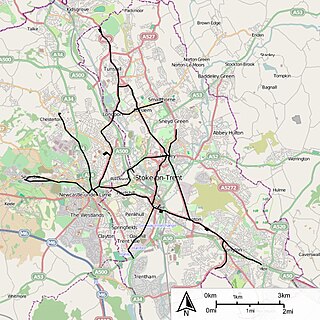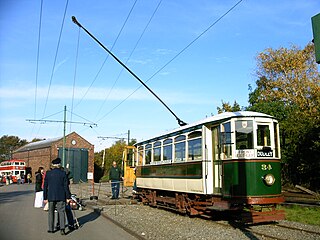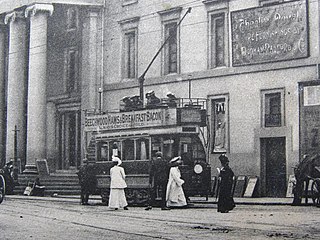
The Tyneside Electrics were the suburban railways on Tyneside that the North Eastern Railway and the London and North Eastern Railway electrified using the third rail system. The North Tyneside loop was electrified from 1904 onwards and formed one of the earliest suburban electric networks; the South Tyneside line to South Shields via Pelaw was electrified in March 1938. British Railways converted these lines to diesel operation in the 1960s: the line to South Shields in January 1963 and the North Tyneside lines in June 1967 when the electrical supply infrastructure and the rolling stock had become life expired. In addition, the system was losing passengers and suffering from costly vandalism. Since the late 1970s, much of the system has been converted to form the Tyne and Wear Metro.
The North Tyneside Loop refers to the railway lines in North Tyneside from Newcastle upon Tyne via Wallsend, North Shields, Whitley Bay, Backworth, Benton and South Gosforth back to Newcastle. Since the 1980s, it has formed part of the Tyne and Wear Metro, albeit in modified form.
The Blyth and Tyne Railway was a railway company in Northumberland, England. It was incorporated in 1853 to unify several private railways and waggonways that were concerned with bringing coal from the Northumberland coalfield to Blyth and to the River Tyne. Over the years it expanded its network to include Ashington, Morpeth and Tynemouth. As coal output increased the company became very prosperous in hauling the mineral to quays for export, and in addition a residential passenger service based on Newcastle built up.

The Lytham St. Annes Corporation Tramways and its predecessor companies operated an electric tramway service in Lytham St Annes between 1903 and 1937.

Southport Corporation Tramways operated a tramway service in Southport between 1900 and 1934.

The Leamington & Warwick Tramways & Omnibus Company operated a tramway service between Warwick and Leamington Spa between 1881 and 1930.

The Potteries Electric Traction Company operated a tramway service in The Potteries between 1899 and 1928.

Walsall Corporation Tramways operated a tramway service in Walsall between 1904 and 1930.

The Kinver Light Railway operated a passenger and freight tramway service between Amblecote and Kinver, in South Staffordshire, between 1901 and 1930.

The Wolverhampton District Electric Tramways Company operated an electric tramway service between Dudley and Wolverhampton between 1899 and 1928.

The Jarrow and District Electric Tramway operated an electric tramway service in Jarrow between 1906 and 1929.
Worcester Tramways Company and its predecessors operated a horse-drawn tramway service in Worcester between 1881 and 1902.
Gravesend and Northfleet Electric Tramways operated a tramway service between Gravesend, Kent and Northfleet between 1902 and 1929.

The Gateshead and District Tramways operated a tramway service in Gateshead between 1883 and 1951.

The tramways in Plymouth were originally constructed as four independent networks operated by three different companies to serve the adjacent towns of Plymouth, Stonehouse and Devonport in Devon, England. The merger of the 'Three Towns' into the new borough of Plymouth in 1914 was the catalyst for the three companies to join up under the auspices of the new Plymouth Corporation. The network was closed in 1945, partly as a result of bomb damage during World War II.
The Provincial Tramways Company was a holding company for horse tramway companies in various regional towns of England. It was floated in July 1872 by means of a prospectus inviting public subscription for shares in the new company. The published prospectus lists the towns where it was proposed to operate horse tramways as Plymouth. Cardiff, Dundee. Portsmouth. Southampton and Tynemouth. Initially those in Plymouth and Cardiff were constructed and in operation as reported to the half yearly meeting of the company in 1873.
The Middleton Electric Traction Company Ltd. operated an electric tramway service in Middleton, England between 1902 and 1925. It was a subsidiary company of the British Electric Traction group,.
















